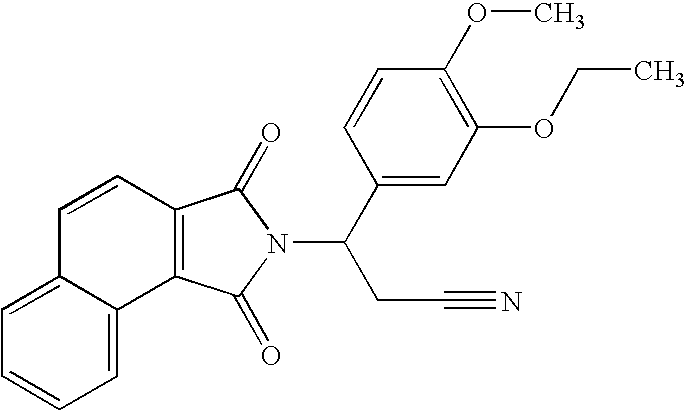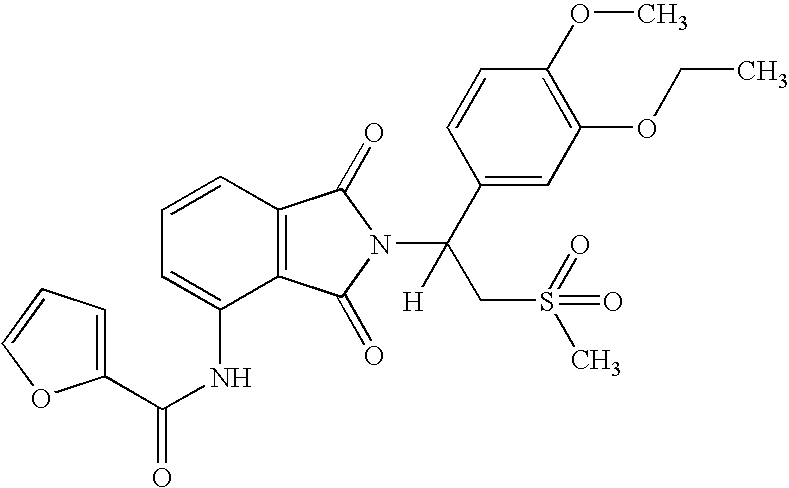Isoindoline compounds and methods of making and using the same
a technology of isoindoline and compounds, applied in the field of isoindoline derivatives, can solve the problems of cancer being particularly devastating, the risk of the spread of cancer, and the breakdown of camp control in these cells
- Summary
- Abstract
- Description
- Claims
- Application Information
AI Technical Summary
Benefits of technology
Problems solved by technology
Method used
Image
Examples
example 1
5.1. Example 1
3-(1,3-Dioxobenzo[e]isoindolin-2-yl)-3-(3-ethoxy-4-methoxyphenyl)propanenitrile
[0139]
[0140] A solution of naphtho[1,2-c]furan-1,3-dione (440 mg, 2.2 mmol) and 3-amino-3-(3-ethoxy-4-methoxy-phenyl)-propionitrile (490 mg, 2.2. mmol) in acetic acid (10 mL) was heated to reflux overnight. The solvent was removed in vacuo to give a solid, which was purified with chromatography (Silica Gel, CH2Cl2) to give 3-(1,3-dioxobenzo[e]isoindolin-2-yl)-3-(3-ethoxy-4-methoxyphenyl)propanenitrile as a yellow solid (430 mg, 48% yield): mp 163.0-165.0° C.; 1H NMR (CDCl3) δ 1.46 (t, J=7 Hz, 3H, CH3), 3.34 (dd, J=7, 17 Hz, 1H, CHH), 3.80-3.92 (m, 1H, CHH), 3.84 (s, 3H, CH3), 4.10 (q, J=7 Hz, 2H, CH2), 5.67 (dd, J=7, 10.1 Hz, 1H, NCH), 6.82-6.86 (m, 1H, Ar), 7.11-7.13 (m, 2H, Ar), 7.61-7.74 (m, 2H, Ar), 7.81 (d, J=8 Hz, 1H, Ar), 7.92 (d, J=7.9 Hz, 1H, Ar), 8.14 (d, J=8.3 Hz, 1H, Ar), 8.87 (d, J=8 Hz, 1H, Ar); 13C NMR (CDCl3) δ 14.66, 21.22, 50.97, 55.91, 64.48, 111.43, 112.19, 117.00, 118.4...
example 2
5.2. Example 2
(1S)-Furan-2-carboxylic acid {2-[1-(3-ethoxy-4-methoxyphenyl)-2-methanesulfonyl-ethyl]-1,3-dioxo-2,3-dihydro-1H-isoindol-4-yl}-amide
[0141]
[0142] A solution of (1S)-7-amino-2-[1-(3-ethoxy-4-methoxyphenyl)-2-methanesulfonyl-ethyl]-2,3-dihydro-isoindol-1-one (0.85 g, 2.0 mmol) and 2-furoyl chloride (0.40 mL, 4.1 mmol) in THF (5 mL) was heated to reflux for 17 hours. To the mixture was added methanol (4 mL). The solvent was removed in vacuo to give a solid, which was purified with chromatography (Silica Gel, EtOAc / hexane) to give (1S)-Furan-2-carboxylic acid {2-[1-(3-ethoxy-4-methoxyphenyl)-2-methanesulfonyl-ethyl]-1,3-dioxo-2,3-dihydro-1H-isoindol-4-yl}-amide as a solid (380 mg, 37% yield): mp 184-186° C.; 1H NMR (CDCl3) δ 1.45 (t, J=7 Hz, 3H, CH3), 2.86 (s, 3H, CH3), 3.76-3.80 (m, 1H, CHH), 3.83 (s, 3H, CH3), 4.10 (q, J=7 Hz, 2H, CH2), 4.56 (dd, J=10, 14 Hz, 1H, CHH), 5.90 (dd, J=5, 10 Hz, 1H, NCH), 6.57-6.58 (m, 1H, Ar), 6.81-6.84 (m, 1H, Ar), 7.10-7.13 (m, 2H, Ar), 7....
example 3
5.3. Example 3
(1S)-N-{2-[1-(3-ethoxy-4-methoxyphenyl)-2-methanesulfonyl-ethyl]-1,3-dioxo-2,3-dihydro-1H-isoindol-4-yl}-2-methoxy-acetamide
[0143]
[0144] A solution of (1S-7-amino-2-[1-(3-ethoxy-4-methoxyphenyl)-2-methanesulfonyl-ethyl]-3-dihydro-isoindol-1-one (0.5 g, 1.2 mmol) and 2-methoxyacetyl chloride 0.3 mL, 3.2 mmol) in THF (6 mL) was heated to reflux for 17 hours. To the mixture was added methanol (5 mL). The solvent was removed in vacuo to give a solid, wich was purified with Prep HPLC to give (1S)-N-{2-[1-(3-ethoxy-4-methoxypheny)-2-methanesulfonyl-ethyl]-1,3-dioxo-2,3-dihydro-1H-isoindol-4-yl}-2-methoxy-acetamide as an off-white solid (180 mg, 32% yield): mp 151-153° C.; 1H NMR (CDCl3) δ 1.47 (t, J=7 Hz, 3H, CH3), 2.84 (s, 3H, CH3), 3.56 (s, 3H, CH3), 3.77 (dd, J=5, 14 Hz, 1H, CHH), 3.85 (s, 3H, CH3), 4.08 (s, 2H, CH2), 4.12 (q, J=7 Hz, 2H, CH2), 453 (dd, J=10, 15 Hz, 1H, CHH), 5.87 (dd, J=5, 10 Hz, 1H, NCH), 6.81-6.82 (m, 1H, Ar), 7.10-7.13 (m, 2H, Ar), 7.51 (d, J=7 HZ, 1...
PUM
 Login to View More
Login to View More Abstract
Description
Claims
Application Information
 Login to View More
Login to View More - R&D
- Intellectual Property
- Life Sciences
- Materials
- Tech Scout
- Unparalleled Data Quality
- Higher Quality Content
- 60% Fewer Hallucinations
Browse by: Latest US Patents, China's latest patents, Technical Efficacy Thesaurus, Application Domain, Technology Topic, Popular Technical Reports.
© 2025 PatSnap. All rights reserved.Legal|Privacy policy|Modern Slavery Act Transparency Statement|Sitemap|About US| Contact US: help@patsnap.com



